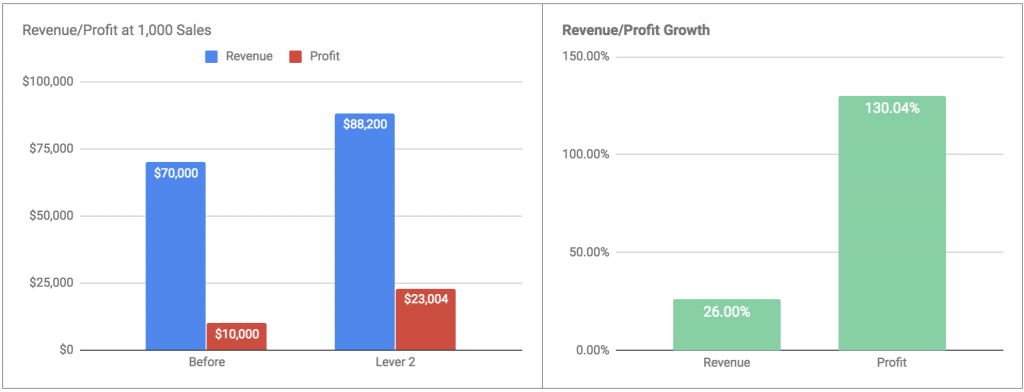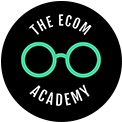How To Double Your Business Without Spending Another Cent (Part 2/3)
Written by Mark Patchett, founder of The Ecom Academy
This is a three part series containing (legendary) info on how to double your business without spending another cent.
—
In our previous article we dug into the first lever you need to pull to double your business; optimising your contribution margin and average order value. We successfully increased our average order value by 26% while increasing profitability by 60.50% – well done!
This is what our numbers are going to look like after this article:

Our focus here is on boosting our profit. Revenue stays flat while profit jumps by 91.70% when compared to where we started!
Lever 2: Conversion Rate
Your conversion rate is the one little bitty metrics that improves every other single metric in your business (with the exception of the customer service team needing to deal with more order enquiries #SorryNotSorry.
There’s so much magic here as when your conversion rate increases you get MORE customers from THE SAME amount of traffic/cost.
More customers. Same cost.
Same cost. More customers.
Amazing.
Said in another way, you drive more transactions AND you pay less for each of them. We could honestly wrap up the three part series after this article BUT things only get steamier when your conversion rate starts to samba with our final lever as well…so stayed tuned.
Let’s chuck in some numbers:
In our scenario, we’ve already increased our order value up to $88.20 at a CPA of $15 (the marketing cost to drive the sale).
To illustrate the impact of our conversion rate on our CPA, we’ll need to model out what our conversion rate is. You can achieve this in a few ways, but a handy trick is to divide your CPC by your CPA. So that’s your cost per click (all the money you spend on marketing divided by your clicks) divided by your average cost per transaction.
In our example our Blended CPC is $0.50 and our CPA is $15 which gives us a conversion rate of 3.33%
On our mission our aim is to give our good friend conversion rate a kick up by 26% (not to 26% but by 26%). If your Ecom CNVR is 26%, call me now, we need to talk.
Conversion rate is a epic topic, so for now I’ll cover the concept of my methodology with some actionable ideas.
A high level approach to CRO
I approach CRO (conversion rate optimization) in a few ways:
Technical:
Is your website working as intended. People are often so used to using their own website AND typically on the same device that they can easily miss a bunch of technical errors that are holding the site back from optimum performance.
Losing money from technical errors is quite literally like relieving yourself into the wind.
A handy way to start digging is the device and browser reports in Google Analytics to look for big variances in transaction conversion rate. Sort by users or sessions highest to lowest then look for transaction opportunity.
A major technical factor (which is becoming more and more critical) is the speed of your site. Just like how conversion rate will improve all your metrics, so will site speed.
People now have a shorter attention span than goldfish (fact), so any delay = lost customers. If you want a reality check about how your speed is looking, head to the Google PageSpeed Insights Tool to see where you stand. You want to be over 90 for mobile AND desktop.
The best way to find other technical issues, is through Usability testing, as per below.
Usability:
If your website isn’t super easy to use, even if people like what you’re offering, you’re going to lose sales. Period.
Many people feel that their website should be an artistic masterpiece yet the job of a website IS NOT to be pretty but to be exceptionally effective in turning users into money.
The challenge is of course discovering what these issues and opportunities are.
A cheap and easy yet highly effective way to get started:
My preferred method is to first take advantage of friends and family who may not use your site all the time. The aim here is NOT to get their opinion on colours, or branding, it’s to observe how they use your site from a functionality standpoint.
Give them a basic challenge to purchase a common product using a similar funnel flow based on your typical customer (e.g. if you’re driving the majority of sales from Facebook, show them a Facebook ad, and start them where your ad links to. From there get them to browse and purchase like a normal visitor would while you observe. You’ll be amazed at what you find, e.g. you’ll find filters that don’t work, funky search results, navigation buttons that don’t make sense, weird products showing up in the category pages and much more. If you’re looking for completely random people, head to Trymyui.com.
Bonus: also try adding exit and onsite poles using a service like HotJar.com. With these surveys you can simply ask “Is there anything that we could be doing better?”. You’ll find that people are very happy to be honest (expect 25% of responses to say “yes, stop showing this stupid popups!” – all in the name of research!)
Your Offer/Pricing:
Assuming that your website isn’t functionally horrific, arguably the most important conversion element is YOUR OFFER. If you have a great price for a great product (particularly if you’re selling the best offer for a branded product e.g. Samsung, Nike), people will jump through rings of fire to buy what you’ve got. I once had a client who’s website looked like it was spat out of the dark ages, it was next to impossible to purchase, yet the conversion rate was unbelievable – all because his product was $5 cheaper than the next guy.
If you can’t move on price, consider how you can increase value, e.g. whether through a rewards program, a free gift, free upgraded shipping etc.
Traffic Quality:
As the saying goes “guano in, guano out”. If you’re driving crappy traffic to your site, your conversion rate will take a hit. I have built a methodology called ClickSmart Analysis, that allows you to quickly identify dirty traffic to then wipe it clean while also finding untapped oil wells of opportunity.
The easiest place to start when looking to improve traffic quality is to focus on the 98% or so that isn’t converting. (Average Ecom conversion rates sit at 2-3% on sessions). So how do you do this? Take advantage of GA to drill down into what campaigns have super high bounce and exit rates. Then go deeper to assess a time on site that would indicate a rubbish user, e.g. 5 seconds. Then work backwards to assess which sources and campaigns can be culled.
Segmentation:
The aim is to be able to speak to customers on as much of a one to one basis as possible. Achieving that is all about using both basic and advanced segmentation with personalisation strategies.
When starting out, ensure you’re emailing previous customers differently to potential prospects. Your returning customers can be one of the most powerful ways for you to increase your conversion rate, as you’ve done all the hard work already! There are many different layers of segmentation and personalisation that we’ll be covering in-depth with follow up guides.
Life Cycle Marketing:
This aspect is quite a bit more advanced. The aim is to understand the buying cycle someone goes through, to then use a combination of segmentation paired with email automation and/or segmented retargeting audiences to ensure that the people that you’re delivering the most relevant message at the right time. E.g. if someone visited for the first time, didn’t buy, but we have them pixeled or their email, we have the opportunity to follow up with them immediately, then 24 hours after, 72 hours after etc. We know that as time passes we’ll need to tweak our message and/or offer to get them to come back. This is an awesome article that goes deeper.
Tactical Promotions:
This is all about how to repackage and rework inventory that is hard to move in a way that attracts a super high conversion rate. Very powerful. Do you have any promotional inventory or excess inventory that you could clear and use as an opportunity to drive high converting sales? Perhaps you could bundle that inventory with other higher margin products as well…
Ok, back to the numbers!
So our existing conversion rate was 3.33%, after actioning the above we’ve definitely upped our performance by 26%, which brings us to 4.21%. 💥💥💥
To backout our new CPA, we divide our CPC by the new conversion rate. So $0.50/4.21% = $11.88!
To recap, when we started our profit per order was $10, we then moved to $16.05 and NOW we’re at $19.17!
At 1,000 sales a month you’d now drive an extra $9,170 in P.R.O.F.I.T! Think of that increase in profitability relative to what you’re turning over..any ideas how you could use that extra moula?
—
Well done team, we’re two levers down, one to go!
Up next we’re we’re going to be covering how to get your existing customers coming back for more and more. Read on here.
Companies our team has worked with:











